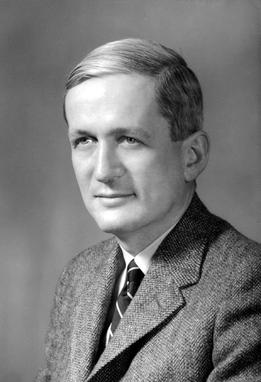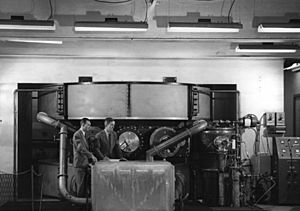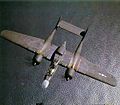Norman Ramsey Jr. facts for kids
Quick facts for kids
Norman Foster Ramsey Jr.
|
|
|---|---|
 |
|
| Born | August 27, 1915 Washington, D.C., U.S.
|
| Died | November 4, 2011 (aged 96) Wayland, Massachusetts, U.S.
|
| Alma mater | |
| Known for | Ramsey interferometry |
| Relatives | Anne Ramsey (cousin) |
| Awards |
|
| Scientific career | |
| Fields | Physics |
| Institutions | |
| Doctoral advisor | Isidor Isaac Rabi |
| Doctoral students |
|
| Other notable students | Sunney Chan (post doc) |
Norman Foster Ramsey Jr. (born August 27, 1915 – died November 4, 2011) was an American physicist. He won the 1989 Nobel Prize in Physics for inventing a special method called the "separated oscillatory field method." This method was very important for building super-accurate atomic clocks.
Ramsey taught physics at Harvard University for most of his career. He also worked with government groups like NATO and the United States Atomic Energy Commission. He helped start important science places like the United States Department of Energy's Brookhaven National Laboratory and Fermilab.
Norman Ramsey's Early Life
Norman Foster Ramsey Jr. was born in Washington, D.C., on August 27, 1915. His mom, Minna Bauer Ramsey, taught at the University of Kansas. His dad, Norman Foster Ramsey, was an officer in the U.S. Army. He became a brigadier general during World War II.
Because his dad was in the Army, Norman moved around a lot as a kid. He even lived in France for a while. Moving often helped him skip a few grades in school. He finished high school in Leavenworth, Kansas, when he was just 15 years old.
College and Early Discoveries
Norman's parents wanted him to go to West Point, a military academy. But he was too young at 15. So, in 1931, he started studying engineering at Columbia University. He soon found he loved mathematics and changed his main subject. By the time he got his first degree in 1935, he was really interested in physics.
Columbia gave him a scholarship to study at Cambridge University in England. There, he learned about quantum mechanics, a new and exciting area of physics. He met many famous scientists like Lord Rutherford.
After Cambridge, Ramsey went back to Columbia to work on his PhD. He joined the team of Isidor Isaac Rabi, a scientist who later won a Nobel Prize. Ramsey and Rabi's team invented a new way to study tiny particles called "molecular beam resonance spectroscopy." Using this method, they discovered that the atomic nucleus (the center of an atom) was not perfectly round, as people thought. This was a big surprise! Ramsey earned his PhD in physics in 1940.
Norman Ramsey During World War II
In 1940, Norman Ramsey married Elinor Jameson and started teaching at the University of Illinois at Urbana–Champaign. But World War II changed their plans.
Improving Radar Technology
In 1940, British scientists brought a new invention called the "cavity magnetron" to the U.S. This device could make powerful microwaves, which were perfect for improving radar. Radar helps detect objects using radio waves. A special lab, the Radiation Laboratory, was set up at Massachusetts Institute of Technology (MIT) to develop this new radar. Ramsey was one of the scientists asked to join.
Ramsey's team worked to make the magnetron better and smaller. They wanted radar to use shorter waves, which would make it more effective. He even traveled to Britain to share ideas with other scientists. Their work led to new radar systems that were used in planes, like the Northrop P-61 Black Widow night fighter.
The Manhattan Project
In 1943, Ramsey was asked to join the Manhattan Project. This was a top-secret project to build the first nuclear weapons. Ramsey's job was to help design and deliver these new weapons.

First, he had to figure out which planes could carry the bombs. Only two planes were big enough: the British Avro Lancaster and the American Boeing B-29 Superfortress. The U.S. military wanted to use the B-29. Ramsey oversaw tests where fake bombs were dropped from B-29s to make sure everything worked. They found and fixed many problems during these tests.
Ramsey also helped plan how the bombs would be used in real combat. He went to Tinian, an island in the Pacific, with the team that would assemble the bombs. He was involved in putting together the "Fat Man" bomb. After the bombing of Hiroshima, he sent the message that the mission was successful.
Norman Ramsey's Research and Discoveries
After the war, Ramsey went back to teaching and doing research at Columbia University. He continued his work on molecular beams with Rabi. Together, they helped create the Brookhaven National Laboratory on Long Island. In 1947, he moved to Harvard University, where he stayed for 40 years.
The Separated Oscillatory Field Method
Ramsey wanted to make very accurate measurements of atoms and molecules. He found it hard to create perfectly steady magnetic fields, which he needed for his experiments. So, in 1949, he invented the "separated oscillatory field method." This new technique allowed him to make much more precise measurements.
Ramsey and his student Daniel Kleppner also developed the atomic hydrogen maser. A maser is like a laser, but it uses microwaves instead of light. They used it to measure tiny details of atoms, like their hyperfine separations.
Atomic Clocks and the Nobel Prize
Ramsey's work was key to developing extremely stable clocks based on hydrogen masers. His "separated oscillatory field method" became super important for atomic clocks. These clocks are incredibly accurate and are used to define the length of a "second." For example, the second is defined by the vibrations of a cesium-133 atom, a concept that builds on Ramsey's discoveries.
In 1989, Norman Ramsey won the Nobel Prize in Physics. He received it "for the invention of the separated oscillatory fields method and its use in the hydrogen maser and other atomic clocks." He shared the prize with two other scientists, Hans G. Dehmelt and Wolfgang Paul.
Ramsey also worked on applying his methods to beams of neutrons. He measured how neutrons act like tiny magnets. As the head of the Universities Research Association in the 1960s, he helped design and build Fermilab, a major particle physics lab in Illinois.
Later Life and Awards
Norman Ramsey retired from Harvard University in 1986, but he kept doing physics research. He spent time at the Joint Institute for Laboratory Astrophysics (JILA) and taught at other universities.
Besides the Nobel Prize, Ramsey received many other awards. These included the Ernest Orlando Lawrence Award in 1960, the IEEE Medal of Honor in 1984, and the National Medal of Science in 1988. He was also a member of important scientific groups like the National Academy of Sciences.
His first wife, Elinor, passed away in 1983. He later married Ellie Welch. Norman Ramsey died on November 4, 2011. He was survived by his wife, his four daughters, and his stepchildren.
Images for kids
-
The Northrop P-61 Black Widow night fighter was specifically designed to take advantage of the new radar.
See also
 In Spanish: Norman Foster Ramsey para niños
In Spanish: Norman Foster Ramsey para niños




